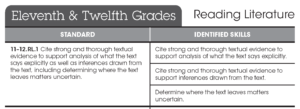Share this article.
The Common Core State Standards established common guidelines for English language arts (ELA) as well as for literacy in history/social studies, science, and technical subjects. Because students must learn to read, write, speak, listen, and use language effectively in a variety of content areas, the standards promote the literacy skills and concepts required for college and career readiness in multiple disciplines. They defined a vision of what it means to be literate person in the 21st century. (National Governors Association Center for Best Practices & Council of Chief State School Officers, 2010)
But, did you know that they do more than just articulate a common set of expectations for what it means to be college- and career-ready?
The standards provide a framework of patterns, parallels, and progressions that seamlessly lend themselves to integration, which as we stated in another article, is the key to providing efficient instruction that supports students in developing the skills to gather information from text, think critically about that information, and produce their thinking around the information. That’s why we provided a series of articles with the support you need to analyze those patterns, parallels, and progressions along and the tools you need to build your own integrated literacy units and lessons.
This article focuses on the how to break down each standard into its measurable and achievable skills and then provides support for identifying where students are in the mastery of those individual skills within the standards, and how to leverage that when planning literacy instruction.
Let’s go…
Why Determine Measurable and Achievable Skills?
The standards were designed as clear learning progressions from the kindergarten standards to the College and Career Readiness (CCR) standards, which define the ultimate expectations in each strand and anchor the grade-specific standards.
“The [standards] define what students should understand and be able to do by the end of each grade. They correspond to the College and Career Readiness (CCR) anchor standards [sic] by number. The CCR and grade-specific standards are necessary complements—the former providing broad standards, the latter providing additional specificity—that together define the skills and understandings that all students must demonstrate.” (National Governors Association Center for Best Practices & Council of Chief State School Officers, 2010)
The grade-level standards were intentionally crafted as a clear and cumulative path from kindergarten to college and career readiness. But they define end-of-year expectations. Each one is too complex to be taught—and mastered—in one lesson but each one is a combination of distinct skills. Just like a jigsaw puzzle has many pieces that fit together to form one picture, a standard has several pieces that fit together to form the end-of-year expectation. Every standard, therefore, must be carefully analyzed to determine the measurable and achievable skills within it. This is especially important when using adopted materials that provide guidance for which standard is being addressed, but not necessarily the skill within the standard. It is then incumbent on the teacher to analyze and identify in what skill within standard is being focused on and provide that information to the students.
So, how is this done?
Identifying Skills within the Standards
There is a pattern to every standard and when you understand it you can easily begin to determine and identify the measurable and achievable skills. It’s similar to the old-school strategy of diagramming sentences. You begin by looking for the nouns and verbs in the standard.
Each standard has a verb (the skill or skills) attached to nouns (the content that the skills must address). These can be single words or phrases depending on the context. Once identified, the standard can be broken into outcomes by skill, by content, or by both.
Take, for example, Standard 1 from Reading Literature in First Grade (1.RL.1): Ask and answer questions about key details in a text. This standard has two skills—ask questions and answer questions—attached to the same content—key details in a text. Therefore, this standard has two measurable and achievable skills.
Let’s look at another example, Standard 1 from Reading Literature in Sixth Grade (6.RL.1): Cite textual evidence to support analysis of what the text says explicitly as well as inferences drawn from the text. This standard has one skill—cite textual evidence to support analysis—attached to two parts of content—what the text says explicitly and inferences drawn from the text. Therefore, this standard has two measurable and achievable skills.
And the last example in this article comes from Standard 1 from Reading Literature in Eleventh and Twelfth Grades (11–12.RL.1): Cite strong and thorough textual evidence to support analysis of what the text says explicitly as well as inferences drawn from the text, including determining where the text leaves matters uncertain. This standard one skill—cite strong and thorough textual evidence to support analysis—attached to two parts of content—what the text says explicitly and inferences drawn from the text. But, this standard also has a new skill that was introduced in the Learning Progression at Eleventh and Twelfth Grades—determine where the text leaves matters uncertain. Therefore, this standard has three measurable and achievable skills.
Implementing the Mastery Sequence of Skills
Remember, each standard is not designed to be addressed as a whole, nor should its skills be addressed in one lesson but over a series of lessons—from initial instruction of each skill to practice to application to integration of the skills in the standard and with other standards—until it is mastered, which means the students have the ability to transfer the skill across time. This is the Mastery Sequence of instruction.
The Mastery Sequence is built upon the notion of conceptual redundancy of the skill or content being learned. The Mastery Sequence ensures that students have opportunities for repetition with the same concept in a variety of approaches. The Mastery Sequence can be used to drive decisions when building an English language arts scope and sequence with an integrated approach. And using an integrated approach ensures that students are provided multiple and varied opportunities to grapple with the same skill or concept. This usually includes opportunities to listen about, talk about, read about, and write about the skill or concept.
Above All, the Teacher Is the Decision-Maker
This pattern of determining the measurable and achievable skill by identifying the verb (the skill or skills) attached to nouns (the content that the skills must address) is just that, a pattern, a formula, a starting point. It is not intended to supersede a teacher’s expertise and knowledge of their students.
The skills should be identified based on what the standard is asking, where it fits in the learning progression, and where students are in the mastery of the skills and the scope and sequence. And the skills should be taught in a sequence that ensures the most effective and efficient learning. These decisions—both in deriving skills from the standards and the sequence of learning—are under the purview of you, the teacher. The teacher as the professional decision-maker is most crucial in this endeavor.
Focusing on the Skills within the Standards Develops Learnership
The Common Core State Standards for English Language Arts & Literacy in History/Social Studies, Science, and Technical Subjects are clear in their ultimate expectations, no matter what the program, textbook, or instructional strategy.
“Students advancing through the grades are expected to meet each year’s grade-specific standards, retain or further develop skills and understandings mastered in preceding grades, and work steadily toward meeting the more general expectations described by the CCR standards.”
So, start looking at the standards in a new way and break them down into measurable and achievable skills that can be taught through the Mastery Sequence. Then check out the other articles in this series to build your learnership around:
- How the patterns in the standards can help students and teachers.
- How the learning progressions in the standards can be used to support students AND their teachers.
- How to utilize the correlations between the strands of literacy to support integration, conceptual redundancy, and mastery.
- How to build integrated literacy units.
Continue the Learning
Check out these articles and resources to continue your learning about this topic…
The Learning Brief
In this article you learned…
- The standards define end-of-year expectations, but each one is too complex to be taught—and mastered—in one lesson and must be broken down into distinct skills.
- There is a pattern to every standard and when you understand it you can easily begin to determine and identify the measurable and achievable skills.
- Just as each standard is not designed to be addressed as a whole, nor should its skills be addressed in one lesson but over a series of lessons—from initial instruction of each skill to practice to application to integration of the skills in the standard and with other standards—until it is mastered, which means the students have the ability to transfer the skill across time.
Can you imagine building an environment full of motivated, engaged, and eager students who own their learning?
We can.





